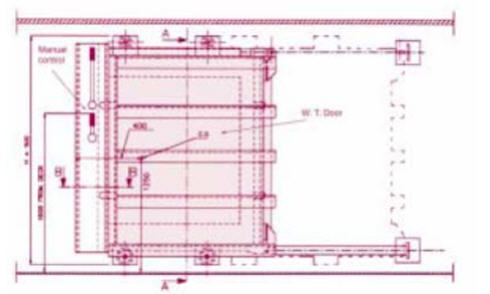Course of events
During repair work on board a passenger vessel alongside, a subcontractor representative was found to have been squeezed to death by a watertight door.
Extent of damage
One person killed.
Probable cause
The probable cause of the accident was that the worker was caught by the door closing as he was passing through the doorway.
Very often persons involved in such accidents have not allowed sufficient time to open the door fully before passing, making the door open just enough to pass through. If loosing the grip of the manual control at the door (at the entrance side), the door will reverse itself when in the "door closed" mode and start closing again immediately after the lever is released. (See extract from SOLAS Chapter II-1 Reg.15.8.1 below.) If then caught by the door, it may be very difficult to reach the manual door control again in time.

Example of w.t.door, for illustration purposes.
As the intention with these doors is to make the passageway in the bulkhead watertight, the closing force is more than sufficient to kill a person if squeezed in-between. See enclosed sketch of a door for illustration purposes. (The handle for opening the door can also be clearly seen.)
Normal operation may be to keep the watertight doors closed when at sea, but the "master mode" switch on the bridge is not set to "doors closed" mode. Hence, it is possible that the crew develop routines or behaviours along the most frequent operational mode used for the watertight doors at sea or in port which they experience, e.g. the "local control" mode, where the door actually stops in the position when the operating lever is released.
For ships constructed on or after 1 February 1992, the SOLAS Chapter II-1 Reg.15.8.1 applies as follows:
The central operating console at the navigation bridge shall have a "master mode" switch with two modes of control: a "local control" mode which shall allow any door to be locally opened and locally closed after use without automatic closure, and a "doors closed" mode which shall automatically close any door that is open. The "doors closed" mode shall permit doors to be opened locally and shall automatically re-close the doors upon release of the local control mechanism. The "master mode" switch shall normally be in the "local control" mode. The "doors closed" mode shall only be used in an emergency or for testing purposes. Special consideration shall be given to the reliability of the "master mode" switch.
There was no requirement to have indications at the door to show in which mode the door was set from the bridge.
According to the above SOLAS requirement, the opening time should be not less than 20 seconds and not more than 40 seconds.
The door on board this ship was a relatively small door with a closing time of about 8 seconds.
Lessons to be learned
- Understand how the watertight door works before passing through it.
- Open watertight doors fully before passing, and pass through it safely.
- Beware of the setting on "master mode" switch when passing.
- A watertight door with automatic closing may close faster than you believe!
- Owners of passenger vessels constructed before 1 February 1992 should consider applying the above SOLAS requirement for a safer operation of watertight doors on board their ships, if not already done.
Source: Det Norske Veritas